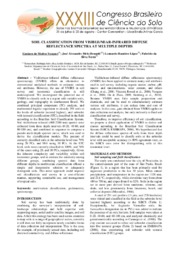Soil classification from visible/near-infrared diffuse reflectance spectra at multiple depths.
Soil classification from visible/near-infrared diffuse reflectance spectra at multiple depths.
Author(s): VASQUES, G. de M.; DEMATTE, J. A. M.; LOPEZ, L. R.; TERRA, F. da S.
Summary: Abstract : Visible/near-infrared diffuse reflectance spectroscopy (VNIRS) offers an alternative to conventional analytical methods to estimate various soil attributes. However, the use of VNIRS in soil survey and taxonomic classification is still underexplored. We investigated the potential use of VNIRS to classify soils in a region with variable soils, geology, and topography in southeastern Brazil. We combined principal component (PC) analysis, and multinomial logistic regression to classify 291 soils at the levels of suborder (second highest), and suborder with textural classification (STC), described in the field according to the Brazilian Soil Classification System. Soil visible/near-infrared (400-2500 nm) spectra were collected from three depth intervals (0-20, 40-60, and 80-100 cm), and combined in sequence to compose a pseudo multi-depth spectral curve, which was used to derive the classification models. The percent of correctly classified soils at the suborder level was 79% using 20 PCs, and 96% using 30 PCs. At the STC level, soils were correctly classified in 100%, and 78% of the cases using 20, and 30 PCs, respectively. Given the inherent complexity and variability within soil taxonomic groups, and in contrast the similarity among different groups, combining spectral data from different depths in multivariate classification offered a simple and inexpensive solution to adequately distinguish soils. This novel approach could improve soil classification and survey in a cost-efficient manner, supporting sustainable use, and management of tropical soils.
Publication year: 2011
Types of publication: Paper in annals and proceedings
Unit: Embrapa Soils
Keywords: Multivariate classification, Pedometrics, spectroscopy
Observation
Some of Embrapa's publications are published as ePub files. To read them, use or download one of the following free software options to your computer or mobile device. Android: Google Play Books; IOS: iBooks; Windows and Linux: Calibre.
Access other publications
Access the Agricultural Research Database (BDPA) to consult Embrapa's full library collection and records.
Visit Embrapa Bookstore to purchase books and other publications sold by Embrapa.

